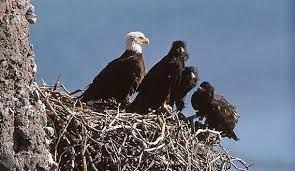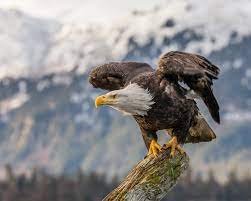In 1782, the bald eagle was chosen as the symbol of the United States of America. It’s a sign of bravery, independence, and power. The emblem appears on paper money and another legal tender in the United States as well as on passports. However, you may be curious as to where bald eagles call home.
To put it simply, bald eagles can only be found in the Americas. You’ll find them all the way from the southern border of the United States to the northernmost parts of Canada and Alaska. Beautiful and magnificent, eagles can be spotted all year long in Alaska and along the west and east coastlines of the United States. It’s possible to spot them in different regions of the country during their winter migration.

Perhaps most significantly, bald eagles tend to congregate near water bodies of significant sizes, such as lakes and rivers. In this area, they do most of their parenting and feeding. Bald eagles spend the winter near rivers, lakes, and other big bodies of water that don’t freeze over. The bald eagle is a traditional American symbol of power, bravery, and independence. The bald eagle was selected in 1782 as our national emblem, and it appears on many U.S. documents and currency to this day.
Also, know What is a Group of Hawks Called?
The bald eagle is a huge, carnivorous raptor that may be identified by its brown body and wings, white head and tail, and hooked yellow beak. They have yellow bodies and black talons on their feet. Young bald eagles look considerably different from their adult counterparts; they are mostly brown with some white on the undersides of their wings and breast. Juveniles have dark brownish-black bills when they are young, but as they mature, the bills become yellow and the rest of their bodies become white. The adult bald eagle typically reaches a height of 2.5 to 3 feet (0.7 to 0.9 metres) and a wing span of 6.5 feet (2.0 to 1.9 metres) (two meters). The female bald eagle is larger than the male, yet they both have the same patterning.
In which countries do bald eagles typically reside?

Bald eagles can be found in all 50 states of the United States, Alaska, and Canada, and even parts of Mexico. Only in Hawaii are bald eagles absent from the 50 United States.
Bald eagles are found in Canada, the United States, and Mexico. The United States has the baldest eagles of the three countries listed. That may seem obvious, but it is virtually entirely due to American control of Alaska. Even though the lower 48 are making a recovery, new statistics suggest that Alaska is still home to more than half of the world’s bald eagle population.
Roughly 20,000 eagles can be found in the wilds of British Columbia and Mexico combined. Eagles tend to congregate near water, yet there are still native populations in every country.
Where can you find bald eagles in their natural environment?

Forested, mountainous, or semi-mountainous areas near water sources including estuaries, lakes, reservoirs, rivers, and the seashore are favoured by bald eagles.
It’s true that bald eagles frequently choose lofty treetops for their nests, but occasionally they choose more practical ground locations. Nests on the ground are more common in coastal areas or in treeless areas like much of Alaska, the Californian islands, and some sections of Canada.
Bald eagles typically build their nests in large, old trees, although they will use dead trees if they are strong and stable enough. Food availability is the primary factor in determining a habitat’s viability.
The bald eagle is most at home near water, whether it be a river, lake, or ocean. Nesting sites for these birds are typically found in large, old trees. The Eagle’s preferred diet of fish is readily available in this habitat.
However, when fish are scarce, bald eagles will switch to small animals and reptiles. Additionally, they enjoy an “easy feed” and will eat dead animals. This is the bald eagle’s primary method of finding food throughout the winter when many streams are frozen.

Bald eagles in Canada tend to congregate in the province of British Columbia, specifically along the Pacific coast. But they have also been sighted in the Prairie regions and Northwestern Ontario. According to studies, bald eagles look for open nesting sites in trees that are at least 66 feet tall. The birds can keep a watchful eye on their young and any potential threats from up high.
The bald eagle is wary of establishing its nest too close to populated areas. As a result, it prefers to settle in places where it won’t be bothered by humans very often.
Locations Highly Recommended for Observing Bald Eagles

The Alaska Chilkat Eagle Preserve is a great place to see Bald Eagles, as it is a winter home to over 4,000 of these magnificent birds. Eagles can be seen in the wild throughout the lower 48 states, but the best places to see them are in Klamath Basin (Oregon and California), Starved Rock State Park (Illinois), Chassahowitzka National Wildlife Refuge (Florida), Loess Bluffs National Wildlife Refuge (Missouri), Bear River Migratory Bird Refuge (Utah), and North Platte National Wildlife Refuge (Nebraska).
One of the best spots in the world to see Bald eagles is in Brackendale Eagles Provincial Park on the west bank of the Squamish River in Canada.
Here are some of the characteristics that bald eagles look for in a suitable nesting site.
A healthy supply of food, favorable perching conditions, and secure nesting places are all necessities. Eagles may survive in a variety of habitats without the other two, therefore having a plentiful food base is probably the most crucial.
Eagles tend to concentrate around estuaries, rivers, huge lakes, and coastal locations since these are where they are most likely to find food. The large population in Alaska can be directly linked to the abundance of natural resources. Bald eagles in Alaska can grow to such high sizes because of the abundance of fish. For example, 4,000 bald eagles gather on 48,000 acres at the Alaska Chilkat Bald Eagle Preserve to feast on the fish in a single mile of the river. All around the state, people gather to feed the animals.
Bald eagles aren’t just partial to big, old trees when it comes to securing a meal. Their massive (the largest in the world) nests can only be supported by extremely sturdy, old trees. When snow and wind arrive in the winter seasons, smaller trees are more likely to topple or break.
Concluding Remarks

The North American continent includes Canada and Mexico, both of which are home to the bald eagle. They can be located nowhere else on Earth. Although Alaska is a popular breeding ground, these magnificent birds also nest in other parts of the United States.
The only US state where bald eagles are not found in Hawaii. The best places to see bald eagles are in close proximity to water, such as rivers, lakes, and the seashore. That’s because fish is the birds’ go-to meal of choice.





